针织学(双语)课件Chapter15
针织学(双语)课件Chapter12
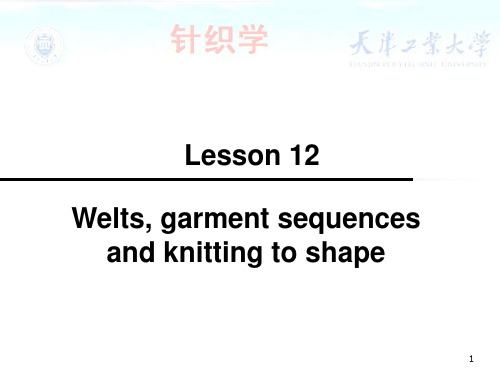
20
12.4.4 Needle selection shaping
In needle selection shaping, the selvedge needle(s) is introduced or withdrawn from the knitting width by means of needle selection. 1.By transferring and re-transferring rib loops in conjunction with needle bed racking 2.By pressing-off loops, or 3.By causing needles to hold their loops for large numbers of traverses
Lesson 12 Welts, garment sequences and knitting to shape
1
12.1 The welt 关边
A welt is an attractive and secure edge of a knitted article that helps to prevent laddering or unroving of a structure.
3.to knit a number of courses in a soluble yarn such as alginate.
13
12.4 Imparting shape during knitting The three methods of width shaping are: 1 varying the number of needles in action in the knitting width 2 changing the knitting construction 3 altering the stitch length.
《针织学Knitting》课件
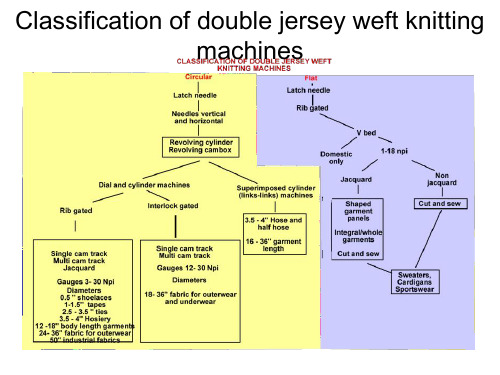
Fabric weight per m² (Fabric Area Density) = Courses/cm x Wales/cm x loop length (cm) x Yarn Tex x C
10³
Production calculations for
circular weft knitting machines
Example
Given a 14 gauge, 20 inch diameter, 40 feeder circular weft knitting machine, operating at 25 rpm and 90 % efficiency . Calculate the length, width, weight/m²and weight per running metre that would be produced per hour using a two fold resultant 50 Tex polyester yarn knitted to the following structures and specifications:
Weft Knitting - Double jersey
fabrics
Notation
Interlock
Weft Knitting - Double jersey fabrics Interlock
Double Jersey Derivative Structures
Double Jersey Derivative Structures
Double ended latch needle
针织学(双语)课件Chapter7

7.4 Multi-step butt set-outs 多级选针齿配置
Straight (diagonal or up-and-up) butt set-out:
The pattern width is equal to the number of available pattern but positions.
10
7.4 Multi-step butt set-outs 多级选针齿配置
Mirror repeat (up-and-down or geometric) butt set-out:
This set-out produces a symmetrical design width.
11
7.5 Selection devices 选针装置
Chapter 7
Pattern and selection devices
1
7.1 Weft knitted patterns 纬编花色织物
Generally, patterns are
produced in weft knitted structures based on a choice of different types of stitch. Patterning is determined by selection of needle butts – either to pass onto a raising cam to knit or to miss the cam
8
7.4 Multi-step butt set-outs 多级选针齿配置
The total number of different heights often
directly influences the width repeat in wales. It is
组织纹织学概念PPT课件
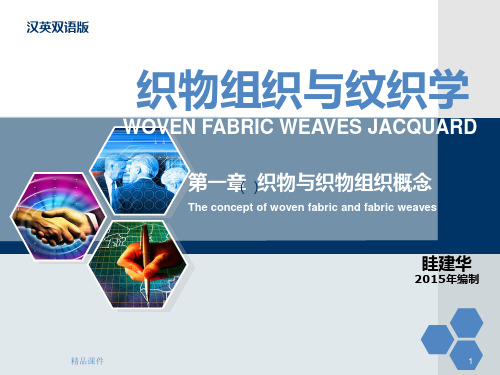
提综 类型
传统机械多 臂织机
现代电子多 臂织机
参照图纸植订纹钉。
直接输入纹板图电子 信号。
气动提综
机械提综
精品课件
25
精品课件
26
第一章 织物与织物组织的概念
The concept of woven fabric and fabric weaves
精品课件
17
第一章 织物与织物组织的概念
The concept of woven fabric and fabric weaves
❖ 1.2.2 交织次数、交错次数、平均浮长
❖ 交错:经纬纱交织时,纱线由浮至沉,或由沉至浮形成一次 交错。
❖ 交织:连续两次交错完成一次交织。 经纱交错次数tj 纬纱交错次数tw
L汉O英双G语O版
织物组织与纹织学
WOVEN FABRIC WEAVES JACQUARD
第一章()织物与织物组织概念
The concept of woven fabric and fabric weaves
眭建华
2015年编制
精品课件
1
关于本课程 ❖纺织工程全概念
设计与制造
设计与制造
设计与制造
纺织原料
8纬纱(weft yarn 9胸梁(breast beam)
11导布辊
12卷布辊(cloth roller)
精品课件
22
第一章 织物与织物组织的概念
The concept of woven fabric and fabric weaves
❖ 穿综(图) (draft plan)——对应经纱穿于对应综框 的图解——指导每根经纱穿入哪片综框(的综丝眼) 的信息表征。
《针织面料培训》PPT课件

烈和迅速的,因此,棉纤维加工时必须避免长时间带碱并与 空气接触,以免纤维素受损。
毛纤维
(一)羊毛纤维的截面形态结构和纵向形态
1、纵向形态:呈鳞片覆盖的圆柱体,具有天然卷曲 2、截面形态:近似圆形 3、截面结构 羊毛纤维由外向里由表皮层、皮质层和髓质层 组成,细羊毛无髓质层
再生纤维
醋酯纤维 化学纤维
合成纤维
再生纤维素纤维 再生蛋白质纤维
二醋酯纤维 三醋酯纤维
粘胶纤维 铜氨纤维
涤、锦、腈、维、氯、丙、氨纶 特种纤维
无机纤维
玻璃纤维、金属纤维、 陶瓷纤维、碳纤维
原
棉
一、常见原棉的种类
1、陆地棉 又称为细绒棉,因最早在美洲大陆种植而得名,
其 纤 维 细 度 的 长 度 中 等 , 手 扯 长 度 为 23--33mm , 细 度 为 143--222mtex左右,一般可纺粗于10tex的棉纱。
ppt课件
7
4、彩色棉与白棉主要物理性能比较
三、棉纤维的形态特征
1、棉纤维的截面形态 正常成熟的棉纤维,截面是不规则的腰圆形,中间有
中腔。未成熟的棉纤维,截面形态极扁,中腔很大。过成 熟的棉纤维,截面呈圆形,中腔很小。(如图)
丝光棉截面
棉特征
棉纤维纵向具有天然转曲,它的纵面呈不规则的而且沿
纤维长度不断改变转向的螺旋形扭曲。成熟正常的棉纤维 转曲最多。未成熟棉纤维呈薄壁管状物,转曲少。过成熟 棉纤维呈棒状,转曲也少。(如图)
ppt课件
10
四、棉纤维的化学组成及耐酸碱性
棉纤维的主要组成物质是纤维素。成熟正常的棉纤维纤维 素含量约为94%。此外,含有少量的多缩戊糖、蛋白质、脂 肪、腊质、水溶性物质和灰分等。
针织学(双语)课件Chapter17
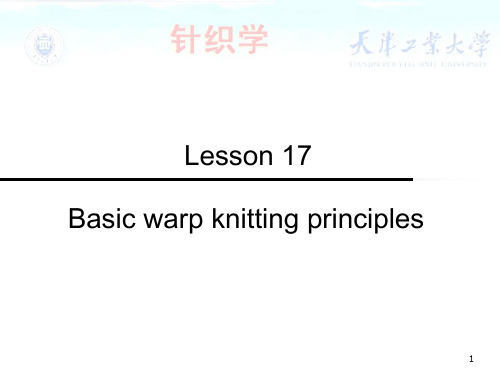
The number of links per course /每横列所需链块数 is fixed for each machine. A minimum of two is usually required, with the underlap occurring between the second link of one course and the first link of the next.
8
The guides
The guide bar
9
17.5 Single needle bar structures
10
A swing motion (fig.17.1 A-A) and a shogging movement (fig.17.1 B-B) act at right-angles to each other in order for their threads to form overlap and underlap paths that combine as one thread path around the needles.
15
17.7 the chain links 链条
A chain notation/垫纱数码记录 is a list ,in correct sequence of chain link numbers, spaced into knitting cycles, for each guide bar necessary to produce a particular fabric structure repeat (Fig.17.4D). The difference between the first two links is normally the overlap.
《针织学Knitting》课件
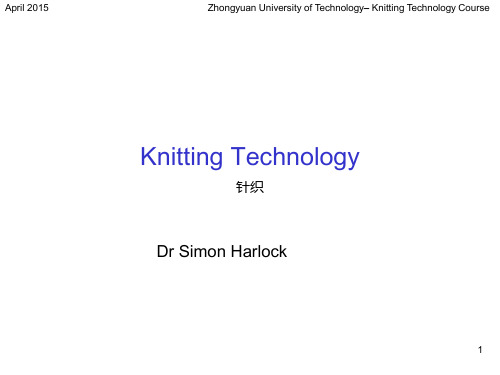
Furnishings 家具 upholstery materials covering both domestic and contract furniture 內飾材料,包 括國內和合同家具 interior trim and the seats of cars. 內飾和汽車座椅 curtain materials - net structures and elaborate lace fabrics幕牆材料 - 網結構和 精心設計的蕾絲面料
5
April 2015
Zhongyuan University of Technology– Knitting Technology Course
Applications of Knitting
Medical textiles. certain types of bandages and wound dressings, artificial tendons and ligaments, and very complex three-dimensional vascular grafts and aortas.
10
April 2015
Zhongyuan University of Technology– Knitting Technology Course
Structure/classification of the Weft Knitting
Industry according to Product types 结构/纬针织行业分类按产品类别
29/04/2015
11:2512:10
Examination
1#102
1#102
1#102
4
April 2015
针织学(双语)课件Chapter1
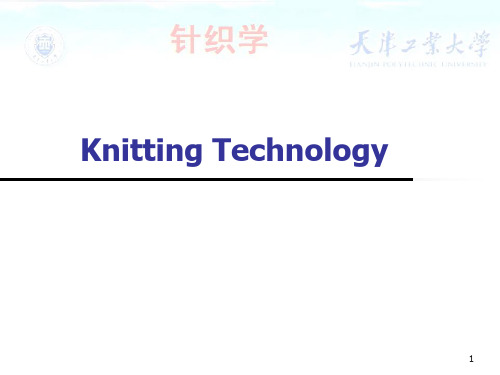
14
1.9 The basic knitting action of a needle
1. The needle is in the rest position. 2. The loop is cleared from the hook to a lower position. 3. The new yarn is fed to the needle. 4. The yarn is formed into a ‘new’loop. 5. The hook is closed. Basic knitting action of a needle 6. The new loop is drawn through the head of the old loop. Simultaneously the old loop is cast off or knocked over. 7. Old loop hangs from the feet of the fully formed new loop.
22
1.11.3 The advantages of the latch needle
1. The rest position. The head of the needle hook is level with the top of the verge of the trick. The loop formed at the previous feeder is in the closed hook.
knitting machine
Warp knitting machine
5
1.1 Machine knitting
needle hook 针钩 newly-fed yarn
针织学原理PPT课件

针织学未来的发展趋势
数字化与智能化
可持续发展
随着信息技术和人工智能的发展,针织学 将更加注重数字化和智能化技术的应用, 以提高生产效率和产品质量。
环保意识的提高将促使针织学更加注重可 持续发展,研究环保型材料和生产技术, 降低对环境的负面影响。
个性化与定制化
跨界融合
随着消费需求的多样化,针织品将更加注 重个性化与定制化的发展,满足消费者的 独特需求。
家纺领域
针织产品柔软的质地和丰富的 纹理使其在家纺领域也大受欢 迎,如床单、毛巾、窗帘等。
医疗领域
针织产品具有良好的透气性和 抗菌性能,适用于制作医疗用 品,如绷带、手术服等。
环保领域
针织产品可降解,适用于制作 环保袋、桌布等环保用品。
针织产品的市场需求与发展趋势
市场需求
随着人们对舒适度和时尚度的追求,针织产品的市场需求不断增长。
针织学将与其他领域(如时尚、医疗、运 动等)进行更多的跨界融合,开发出更多 具有创新性和实用性的产品。
THANK YOU
感谢聆听
袜子设计:分析袜子的结构设计对穿 着舒适度的影响,探讨如何通过合理 的结构设计提高袜子的舒适性。
毛衣设计:研究毛衣的流行趋势,讨 论如何将时尚元素融入毛衣设计,提 高产品的市场竞争力。
05
针织产品应用与市场
针织产品在各领域的应用
服装领域
针织产品因其舒适性和透气性 ,广泛应用于服装领域,如T恤
、毛衣、运动服等。
针织学原理ppt课件
目
CONTENCT
录
• 针织学概述 • 针织原理与工艺 • 针织材料与性能 • 针织产品设计 • 针织产品应用与市场 • 针织学研究与发展
01
针织学概述
针织学(双语)课件Chapter10
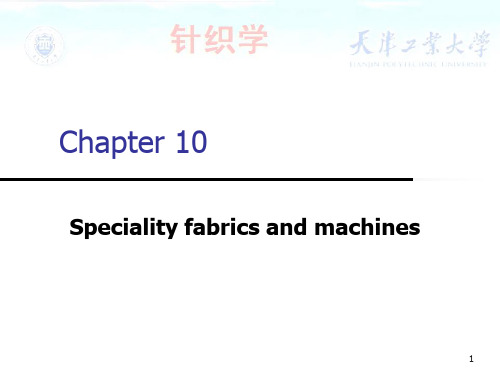
The face yarn prevents the arms of the fleecy
tucks being visible between the wales on the face.
3
A typical knitting sequence for producing three-
thread fleecy/添纱衬垫,三线衬垫:
fleecy yarn 衬垫纱 tie-in yarn 地纱
top throat 上片喉
lower throat 下片喉
4
A typical knitting sequence for producing three-
thread fleecy/添纱衬垫,三线衬垫:
ground yarn 地纱
upper sinker belly 上片颚
7
10.4 Plush 毛圈
The elongated plush sinker
loops/拉长的毛圈沉降弧 are formed over a higher knock-over surface than the normal-length ground sinker loops/地纱沉降弧 with which they are plated. Henkel plush or velour/毛圈绒 is achieved during finishing, by cropping or shearing/剪绒 the plush sinker loops in both directions.
5
A typical knitting sequence for producing three-
thread fleecy/添纱衬垫,三线衬垫:
针织学(双语)课件Chapter21

7.
8.
In order to ‘interweave’/交织 an inlaid yarn vertically with a knitted yarn, it is necessary to cause it to evade for three courses and to miss-lap for one course during the repeat.
7
Fig 21.2 Fall-plate raised out of action
Fig 21.3 Fall-plate lowered into action
21.4 fall-plate patterning 压纱板花型
It is necessary to knit the ground structure overlaps on the guide bars behind the fall-plate because these are unaffected by its descent.
Fig 21.1 The action of inlay in warp knitting
2
21.2 general rules governing laying-in in warp knitting 形成经编衬纬的基本原则
1.
An inlaid yarn will pass across one less wale than a knitted yarn than has the same extent pf underlap. To eliminate the overlap movement (when using a two-link-percourse chain/二行程链条) it is necessary to put two links of the same height at the point where this should take place. The inlaid yarn will be tied in at every wale it crosses (if the overlapping guide bar is in front of it). If the knitting bar underlaps in opposition to the inlay, it will add an extra thread for tying it into the structure. When the laying-in and knitting bars lap in unison, there will be one less thread available for tying in the inlay so that the inlay will be tied-in by one less thread than the number of needles the inlay underlaps.
纬编概述针织学课件-PPT

表示符号
第二节 常用纬编针织机种类
所有针织物的基础。 单面针织圆纬机
一、圆纬机 open cylinder knitting machine
台车(loop wheel machine) 单面提花针织机(single jacquard knitting machine) 特点:直观、繁杂,适用于简单组织。 槽筒式络纱机:用于络取棉、毛及混纺等
每一方格代表一个线圈, 方格内的不同符号代表不 同的颜色。
结构意匠图
定义:将成圈、集 圈和浮线用规定的 符号在方格纸上表 示出来。 ×—正面线圈 ○—反面线圈 ·—集全悬弧
多用于表示单面织物。 □—浮线(不编织)
3.编织图
定义:将织物的横 断面形态,按编织 的顺序和织针的工 作情况,用图形来 表示的一种方法。
第三节 纬编针织前准备
一、络纱的目的
目的:使纱线卷绕成一定形式和一定容量 的卷装,满足编织时纱线退绕的要求。
二、络纱的要求
1.去除纱疵和粗细节,提高针织机生产效 率和产品质量;
2. 对纱线进行必要的辅助处理(如上蜡、 上油、上柔软剂、上抗静电剂等),以 改善纱线的编织性能。
二、卷装形式
1.圆柱形筒子 :卷装容量大,但筒子形状 不太理想,退绕时纱线张力波动较大。
双面针织圆纬机 cylinder and dial machine
棉毛机(interlock machine) 罗纹机(rib knitting machine) 双面提花针织机(double jacquard knitting machine) 双反面机(purl knitting machine) 圆袜机(hosiery machine) 移圈罗纹机(transfer machine) 等
针织学(双语)课件Chapter18

9
18.3.3 The knitting action of the single needle bar raschel machine:
Fig 18.7 Knitting action of a single needle bar latch needle raschel machine.
a. Holding down b. Clearing c. Overlap d. Return swing e. Latch closing/舌针闭 f. Knocking-over and underlap
1.
2. 3. 4. 5. 6. 7. 8. 9. 10.
Tricot machines have a gauge expressed in needles per inch and chain link numbering 0,1,2,3,4,etc.,generally with three links per course. Sinkers drawn-away of their fabric The warp beams The warp sheets Mechanical attention The guide bars’ number The angle of fabric take-away The type of knitting action The machine gauge
Lesson 18
Classes of warp knitting machine
1
18.1 Characteristics of tricot and raschel machine
In the past, tricot machines mainly employed bearded needles with a presser bar and raschels used latch needles together with a latch wire or blade.
《针织学Knitting》课件
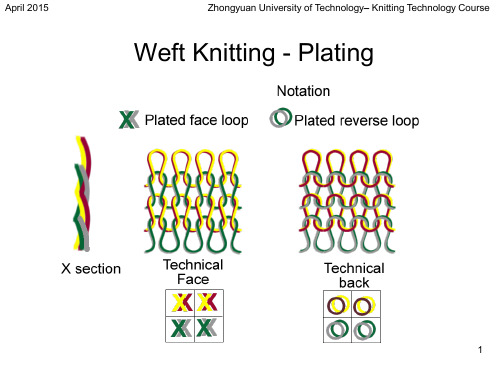
Plush or terry is produced by plating two yarns with one drawn over the nib of the sinker ( longer loop) and one over the belly. Cutting the loop 4 during finishing creates cut pile
Weft Knitting - Plush
Plush or terry is produced by plating two yarns with one drawn longer
than the other
3
April 2015
Zhongyuan University of Technology– Knitting Technology Course
Flat bed weft knitting machines
Fully fashioned machines using bearded needles
Flat purl machines using double ended latch needles
V bed weft knitting machines with normally 2 needle beds but some machines have 4 using latch or compound needles
April 2015
Zhongyuan University of Technology– Knitting Technology Course
Weft Knitting - Fleece
6
April 2015
针织学
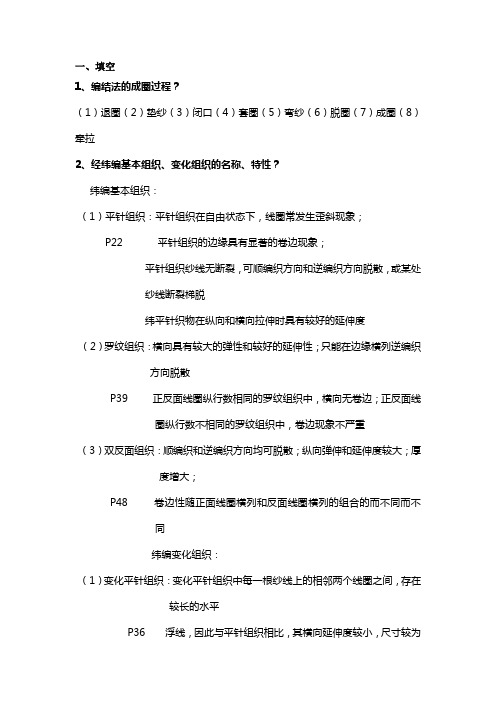
一、填空1、编结法的成圈过程?(1)退圈(2)垫纱(3)闭口(4)套圈(5)弯纱(6)脱圈(7)成圈(8)牵拉2、经纬编基本组织、变化组织的名称、特性?纬编基本组织:(1)平针组织:平针组织在自由状态下,线圈常发生歪斜现象;P22 平针组织的边缘具有显著的卷边现象;平针组织纱线无断裂,可顺编织方向和逆编织方向脱散,或某处纱线断裂梯脱纬平针织物在纵向和横向拉伸时具有较好的延伸度(2)罗纹组织:横向具有较大的弹性和较好的延伸性;只能在边缘横列逆编织方向脱散P39 正反面线圈纵行数相同的罗纹组织中,横向无卷边;正反面线圈纵行数不相同的罗纹组织中,卷边现象不严重(3)双反面组织:顺编织和逆编织方向均可脱散;纵向弹伸和延伸度较大;厚度增大;P48 卷边性随正面线圈横列和反面线圈横列的组合的而不同而不同纬编变化组织:(1)变化平针组织:变化平针组织中每一根纱线上的相邻两个线圈之间,存在较长的水平P36 浮线,因此与平针组织相比,其横向延伸度较小,尺寸较为稳定。
(2)双罗纹组织:延伸性与弹性都较罗纹组织小,尺寸比较稳定;只可逆编织方向脱散;P43 不会卷边经编基本组织:P237-239(1)编链组织:可逆编织方向脱散;纵向延伸性小;线圈圈干直立;形成的织物为条带状,纵行间无联系(2)经平组织:线圈左右倾斜;可逆编织方向脱散;纵、横向延伸性相等(3)经缎组织:由开口和闭口线圈组成,转向处为闭口线圈;部分性能类似于纬平针织物; 织物表面有隐横条效应(4)重经组织:单梳栉1穿1空即可形成织物;有较多的开口线圈,性质介于经、纬编织物之间,脱散性小,弹性好(5)罗纹经平组织:外观与纬编罗纹相似;横向延伸性小于纬编罗纹经编变化组织:P240-241(1)变化经平组织:经绒:横向稳定性较经平好;延伸性,弹性适中;织物表面光滑,手感柔软;延展线较经平长,适宜于起绒经斜:横向稳定,织物厚实(2)变化经缎组织:针背延展线长,织物厚度较经缎组织大(3)双罗纹经平组织:与纬编双罗纹经平结构相似,双罗纹经平组织的正反面线圈纵行也呈相对配置,因此其结构较罗纹经平组织紧密,横向延伸性也较小3、针织机的分类?纬编针织机:圆纬机、横机、圆袜机经编针织机:特利柯脱型经编机、拉舍尔型经编机、特殊类型经编机(钩编机、缝编机、管编机)4、沉降片的组成部分?片鼻、片喉、片颚、片踵5、衬垫组织的结构单元?线圈、悬弧、浮线6、普通毛圈、移圈织物、衬纬经编组织分类?普通毛圈:正包毛圈、反包毛圈、满地毛圈、非满地毛圈 P73移圈织物:纱罗组织(单面、双面纱罗组织)、菠萝组织 P88衬纬经编组织:部分衬纬经编组织(起花和起绒衬纬经编组织、衬纬经编网孔组织)、全幅衬纬经编组织7、缺垫经编组织、缺压集圈经编组织形成效应?P250、P258缺垫经编组织:可以形成褶裥、方格和斜纹等花色效应缺压集圈经编组织:可形成纵条、斜纹、凹凸等效应8、工艺正面和反面?P1凡线圈圈柱覆盖在前一线圈圈弧之上的一面,称为工艺正面。
- 1、下载文档前请自行甄别文档内容的完整性,平台不提供额外的编辑、内容补充、找答案等附加服务。
- 2、"仅部分预览"的文档,不可在线预览部分如存在完整性等问题,可反馈申请退款(可完整预览的文档不适用该条件!)。
- 3、如文档侵犯您的权益,请联系客服反馈,我们会尽快为您处理(人工客服工作时间:9:00-18:30)。
1
15.1 Types of hosiery
Hose, which have a leg-length extending above the knee
3
15.2 Classes of hosiery machines
Except for the few Griswold type hand-turned machines(Fig.4.4), all hosiery machines are of the revolving cylinder type. This arrangement offers the advantages of high revolution speeds, a simplified drive, and the possibility of selectively striping-in yarn from stationary packages placed at fixed feed positions around the cylinder. The three types of hosiery machines, in order of their increasing complexity and needle bed arrangement, are single cylinder, cylinder and dial and double cylinder.
Micromesh is similar although less effective because it contains less tuck stitches.
13
15.8 The development of the double-cylinder machine
The development of specifically designed circular hose machines followed from patents such as those of Newton in 1857 and McNary in 1860. During the 1870s, the patents granted to Henry Griswold virtually perfected the hand-powered sock machine.
2
Stockings, which are designed to fit the leg up to or above the knee and may or may not be selfsupporting
Tights, particularly in fine gauge, which are termed panty-hose in the USA. They may have a body section of the same knitted structure as the legs and an inserted gusset and elasticated waist-band.
11
Speeds and numbers of feeds were then gradually increased, with a six-feed machine running at 210rpm in 1963 and, by 1971, a twelve-feed machine running at 260 rpm. Today, demands for higher quality and more versatility led to a reduction in the number of feeds so that machines now generally have 4 or 6 feeds and commercial operating speeds of 1000-1200 rpm. Recently there has been an increasing use of Lycra and other elastane yarns, in bare or in covered form, at every course or at alternate courses, either by knitting laying-in or plating.
9
15.5 The advent of nylon
With only yarns such as rayon, silk, cotton and worsted available for knitting, bagginess (particularly around the ankle) of ladies’ fine gauge circular knitted seamless hose caused them to be regarded as a cheap but inferior rival to the more shapely fully fashioned hose knitted on the straight bar frame. In the same year, nylon, the ideal stocking yarn, because plentifully available. Not only was it a cheap, strong, fine and uniform yarn, it had the major asset of being thermoplastic .
12
15.7 Ladder-resist structure
Float-plated fishnet Float-plated fishnet is one popular ladder-resist structure 1 ×1 Cross tuck is another ladder-resist structure, where alternate needles tuck at alternate courevelopment of ladies’ fine-gauge hosiery machines
Circular machinery entered hosiery production inauspiciously during the nineteenth century, knitting fabric that was then cut and seamed into cheap ‘leg bags’, onto which heels, soles and toes were handframe knitted.
4
5
15.3 Gauge
On hosiery machines the gauge is usually expressed as diameter and total number of needles. A 4 inch ×400 needle single-cylinder ladies seamless hosiery machine: 400 needles to knit plain. A 4 inch ×200 needle cylinder and dial machine: 200 cylinder needles and 100 dial needles. A 4 inch ×200 needle double-cylinder machine will have a total of 200 needles to knit plain stitches in the bottom cylinder, or, when arranged for 1 ×1rib, will have 100 needles knitting plain in the bottom cylinder and 100 needles knitting rib in the top cylinder.
10
15.6 Trends in fine-gauge hosiery since 1956
The slow and expensive reciprocated and linked-closed toe was replaced on a twin-feed machine in 1956 by allcircular knitted courses of spliced fabric, which was later cut and seam shaped into a toe. In the same year, the Reymes Cole patent described how the reciprocated heel might also be replaced, in this case, by part-circular knitted splicing courses on selected heel section needles. In 1961, the four-feed Bill Zodiac machine popularised the tube stocking with a patch heel by knitting a stocking in 2 minutes 10 seconds. In the early 1950s, it took 12 minutes to knit a stocking.
7
Much of the early development of large- and smalldiameter single-cylinder latch needle machinery occurred in the USA. For many years, both in Britain and the rest of Europe, the products of these machines were considered to be inferior in quality to those knitted on bearded needle machinery or (later) latch needle machines with two needle beds.
